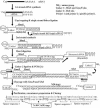Cap analysis gene expression for high-throughput analysis of transcriptional starting point and identification of promoter usage
- PMID: 14663149
- PMCID: PMC307644
- DOI: 10.1073/pnas.2136655100
Cap analysis gene expression for high-throughput analysis of transcriptional starting point and identification of promoter usage
Abstract
We introduce cap analysis gene expression (CAGE), which is based on preparation and sequencing of concatamers of DNA tags deriving from the initial 20 nucleotides from 5' end mRNAs. CAGE allows high-throughout gene expression analysis and the profiling of transcriptional start points (TSP), including promoter usage analysis. By analyzing four libraries (brain, cortex, hippocampus, and cerebellum), we redefined more accurately the TSPs of 11-27% of the analyzed transcriptional units that were hit. The frequency of CAGE tags correlates well with results from other analyses, such as serial analysis of gene expression, and furthermore maps the TSPs more accurately, including in tissue-specific cases. The high-throughput nature of this technology paves the way for understanding gene networks via correlation of promoter usage and gene transcriptional factor expression.
Figures


References
Publication types
MeSH terms
Substances
LinkOut - more resources
Full Text Sources
Other Literature Sources
Miscellaneous

